Exponential Assembly
by
George D. Skidmore*, Eric Parker, Matthew Ellis, Neil Sarkar, and Ralph Merkle
Zyvex Corporation, 1321 North Plano Road, Richardson, Texas
*[email protected]
http://www.zyvex.com/Corporate/Profiles/SkidmoreBio.html
This is a draft paper for the
Eighth
Foresight Conference on Molecular Nanotechnology.
Abstract
A replicative assembly methodology may be based on assembly stations each with two degrees of rotational freedom. These stations share translational degrees of freedom in the three Cartesian axes by using a common translating mechanism. The methodology provides replication of the assembly stations, but due to the common translating mechanism and control systems, it cannot be termed self-replicating. The term "exponential assembly" is proposed to differentiate this from self-replication. The exponential assembly architecture can use parts made from many manufacturing methods, provided that parts of considerable complexity can be produced. Because integrated circuit manufacturing methods used for micro-electro-mechanical systems (MEMS) allow large numbers of complex components to be produced, it is one possible method for pursuing such an approach to manufacturing. The methodology is scalable and therefore useful for producing assembly stations which might in turn produce other devices at ever-decreasing length scales as part of a top-down approach to nanotechnology.
Introduction
Self-replication and nanotechnology are commonly discussed together as it has been suggested that no large-scale nanotechnology industry can develop without self-replication. Progress towards molecular nanotechnology is being made on several fronts, producing breakthroughs in molecular manipulation for chemical bond formation1, molecular electronics2 and the harnessing of bio-molecular motors3. The self-replicating entities of the biological arena are often used as an existence proof for the possibility and inevitability of self-replicating machinery. Simpler, man-made self-replicating machinery, however, has not seen much progress since the demonstrations of the first rudimentary self-reproducing machine demonstrations4,5.
The first artificial, self-replicating mechanical structures were built by Penrose6, and the first electro-mechanical systems were created by Jacobson5 decades ago. The structures used by Penrose showed that it is possible to construct a very simple mechanical analogue for self-reproduction. The demonstration using model railroading parts by Jacobson showed that a self-assembly system using complex parts and one simple assembly step would also result in a self-reproducing analogue. Neither of these systems was able to perform a useful function afterwards, but these experiments did show that mechanical structures could perform self-replication in a somewhat limited way. These authors simplified self-replication by showing that it is not inherently a complex problem and that a rich environment of complex parts and simple reproduction steps reduces the self-replicating problem to a tractable one. Unfortunately, these demonstrations did not address the issues surrounding self-replicating manufacturing systems, as shown in one report still regarding such systems as complex.7
Completely self-replicating systems may not prove necessary for nanotechnology, as simpler systems containing some replicating aspects will undoubtedly be easier to implement. Self-replicating systems can usefully be divided into the replicating component on the one hand, and the environment on the other. It is generally not possible to consider a replicating system without considering an environment also. By providing a more structured and more complex environment, the complexity of the replicating component can be reduced. The self-replicating methodology described in this paper is achieved by providing a very structured and complex environment so that certain aspects of the replication process can be greatly simplified — in particular, the number and complexity of the assembly operations.
During the approach to mature molecular manufacturing, interim systems, showing just enough replicating aspects to assist the progression to more complex, mature assembly systems is desired. In examining the evolution toward nanotechnology, it has been unclear where self-replication would become necessary or even possible. Previously, it had been thought that self-replication could only be introduced near the end of the development process. We may now have the ability to develop and introduce assembly systems containing self-replicating aspects within the foreseeable future.
This report outlines a possible approach to a replication methodology for assembly stations with individual rotational degrees of freedom but having shared translational degrees of freedom and shared control. Relying on an outside source for parts manufacture, this system performs only the simplest assembly operations to complete construction of its individual stations. It thus satisfies a definition of self-replication, but is not a complete self-replicating system. We thus propose a new term, "exponential assembly" to describe this methodology, because the operations performed are assembly operations and after N such assemblies have been performed there can, in principle, be 2N assembled stations.
The System Components
To simplify the required assembly operations, the system shares certain degrees of freedom and instructions, as well as off-loading parts manufacture to some other method. The total assembly system consists of a translating mechanism capable of accurate positioning in the three Cartesian axes, a control system and two surfaces with pre-arranged parts ready for assembly. A schematic of this system is shown below (in Figure 1). The parts can be manufactured and arranged by any known method, making the system accessible to many length scales.
 |
Figure 1. The schematic shows the necessary components for an exponential assembly system. A translating mechanism capable of translating in the three Cartesian axes, a control system for controlling the stations and the shared translating mechanism, and two facing surfaces with pre-arranged arrays of unassembled components. |
The surfaces are divided into grids, with a set of components for a station located at each grid site. The control system knows the location of each part as well as the assembly procedure. Each site on the first surface, defined as surface A, is uniquely addressed by a right-handed Cartesian coordinate system with the convention A(x,y). The lower-leftfirst grid site has address A(1,1), the upper-right hasfinal site has A(n,n) as depicted in Figure 2a. The first step is to manually assemble a single station at die site A(1,1). This is accomplished by whatever means are available, as it only needs to be done once.
 |
| Figure 2a. Two mirror image sufaces for exponential assembly are shown. |
 |
| Figure 2b. Surface B is then rotated 180 degrees about its z-axis and translated such that site B(1,1) is across from A(1,1). |
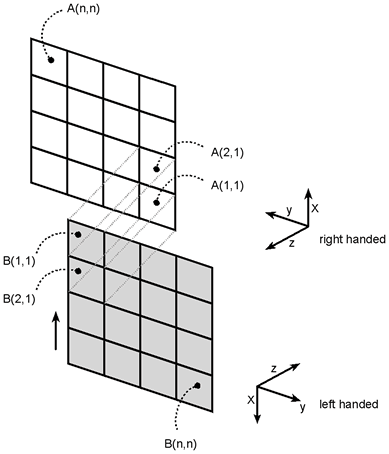 |
| Figure 2c. The next translation locates A(1,1) and B(1,1) across from B(2,1) and A(2,1) respectively as shown here. |
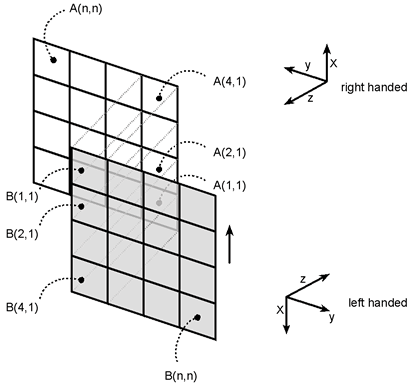 |
| Figure 2d.Translating again positions A(1,1) and B(1,1) across from B(4,1) and A(4,1) respectively as shown here. |
At this point, the first surface has an assembled and functioning station. The functioning station is then placed into the system facing an opposing surface. This second surface, fabricated as a mirror image of the first, contains another set of grid sites with components ready for assembly. This second surface, defined as surface B, is addressed with a left-handed Cartesian coordinate system — thus position with the convention B(x,y). This sites are thus labeled B(1,1) is in the lower right, and position through B(n,n) as shown in Figure 2a. is in the upper left. This surface needs to be arranged to face surface A such that translations are equivalent from each of the reference frames. This is done by rotating surface B 180 degrees about its z-axis as depicted in Figure 2b.
Initially, site A(1,1) is located across from B(1,1). The assembly process is started and station A(1,1) assembles station B (1,1). The assembly process for a suggested station will be outlined in detail in the next section. The station at site A(1,1) is then returned to its as-assembled configuration and the station at B(1,1) is enabled for operation. The surfaces are then translated such that site A(1,1) is across from B(2,1), which implies that the newly constructed B(1,1) is across from A(2,1) as shown in Figure 2c. Because surface B is a mirror image copy of surface A, the same assembly sequence will work for B(1,1) in constructing A(2,1) as works for A(1,1) in constructing B(2,1). The two can perform the assembly sequence simultaneously. When the sequence is completed there is newly assembled stations at A(2,1) and at B(2,1). This iteration ends by returning the operating stations (those at A(1,1) and B(1,1)) to their as-assembled configurations and enabling the newly assembled stations at A(2,1) and B(2,1) for operation. The next large translation locates A(1,1) across from B(4,1) as shown in Figure 2d and the four operating stations can assemble another four. After some number of assembly iterations, each surface contains an entire row of assembled and functioning stations. The next translations will therefore position row A(n,1) across from row B(n,2), which also positions row B(n,1) across from row A(n,2). Entire rows are now assembled simultaneously. After iterating through the rows in a similar manner, both surfaces will be completely assembled. after iterating through the rows.
The Assembly Stations
The assembly station can be configured in many ways with varying degrees of complexity. The exponential assembly station we will describe has the ability to rotate about two orthogonal axes, each with 90 degree range of motion, and the ability to grip and release parts. A schematic of this simple station is shown with the components arranged flat in Figure 3a. The components are quite complex, as is necessary for easy assembly. The base piece contains a rotational stage with an attachment mechanism for connecting the second component. The arm piece contains another rotation stage with an attached arm, terminating with a gripper mechanism. Also shown on the arm piece is a place for gripping the component, termed the handle, as well as the attachment mechanism for connecting to the base component. To assemble the device, the arm piece must be lifted from the surface, rotated about the y-axis and attached to the base piece using the attachment points. If the attachment mechanism is secure, the entire assembly operation is complete and the device is shown in Figure 3b.
The simple two-component assembly station is shown (in Figure 3a) with the parts arranged flat on a surface.
 |
 |
| Figure 3a. The rotational stages are labeled as are the gripper, handle, and attachment points. |
Figure 3b. When the two components are assembled, the assembly station is as shown. |
This first device is now assembled. It has not been discussed with what mechanism this first assembly station is assembled, but an external gripper and set of assembly stages under manual or automated control would likely be sufficient. The translating stages shown in Figure 1, in conjunction with added rotation capability, should suffice. An animation of this first assembly sequence can be found at http://www.zyvex.com/research/exponential.html. Regardless of its construction method, once assembled, the first device is ready to begin the exponential assembly process.
To perform exponential assembly, two arrays of pre-arranged components are mounted facing each other. As discussed above, the second array can be a mirror image of the first. The first assembled station then performs the rotational motions and gripping while the shared translational mechanisms provide the Cartesian displacements necessary to assemble the station on the opposite surface. The assembly operation sequence showing the first component assembling the second is outlined in Figure 4 and in the animation found at http://www.zyvex.com/research/exponential.html. Figure 4a shows the four components comprising two mirror image stations ready for assembly. Figure 4b shows the two components after one has been rotated and positioned such that the two are facing each other in the necessary arrangement. Figure 4c shows the situation after the first component has been assembled by the external mechanism. The assembled station first rotates 90 degrees about the z-axis, as shown in Figure 4d, then it translates to grip the arm-stage as shown in Figure 4e. The base rotation stage of the assembled station then rotates about the y-axis and translates until the attachment points align as shown in Figure 4f. After the attachment is made, the gripper releases and translates. The assembly is now completed, as shown in Figure 4g. The two components are now separated a safe distance and the two rotation stages of the first station are returned to their original, as-assembled configuration. The two assembled stations are now ready to begin another assembly sequence and are translated such that each is across from a fresh set of components. The same sequence of operations is now provided to both assembled stations and they repeat the exponential assembly process until each array of components is assembled. In principle, assuming 100% yield of both components and assembly operations, the sequence produces 2N assembly stations after N assembly sequences.
Shown below is the sequence of assembly operations necessary for the first station to assemble the second.
 |
 |
| Figure 4a. The stations are first shown unassembled. |
Figure 4b. After rotating one of the stations, the two are shown facing each other. |
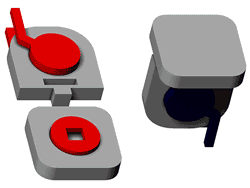 |
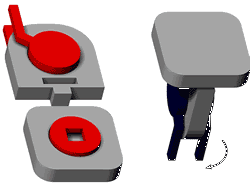 |
| Figure 4c. The first is then assembled. |
Figure 4d. The assembled station first rotates about the z-axis. |
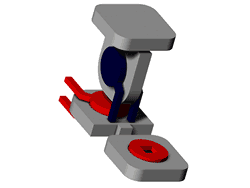 |
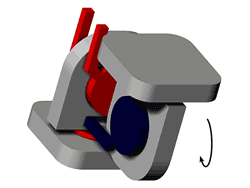 |
| Figure 4e. It then translates to grip the component of the other. |
Figure 4f. The other second rotation stage of station one then rotates 90 degrees and translates such that the attachment points are aligned with translation. |
 |
|
| Figure 4g. After the attachment is made the gripper releases and the assembly is completed. |
|
The assembly rate will suffer if individual devices can not enabled as assumed above. The above sequence of operations presumes that a single station, once assembled, is enabled, or "turned-on" and ready for motion. If another approach is taken — for example, an approach where all of the stations on a surface are "hard-wired" to move simultaneously, even when unassembled — the above operations will not work. This is because the unassembled base rotation stages are moving at an undesirable time. This problem is easily overcome by operating only one surface during an assembly sequence, leaving the other surface inactive. After one sequence, the first surface is made inactive and the second is operated. Thus, the first assembly station assembles first one on the opposing surface, and then another. There are now two assembled on the second surface and one on the first. The second surface is then enabled and used to build two more on the first while the first remains inactive. The end result is a ping-pong mode of assembly where progression follows a Fibonacci sequence instead of the aforementioned 2N sequence. The growth rate of assembled stations has been diminished, but the control system or wiring of stations has been greatly simplified.
We have described a conceptually simple assembly station. In practice, we expect that more complex operations and structures will prove desirable; these more evolved and complex systems evolving naturally from the original concept. For example, the attachment may be insecure and require additional bracing support, which can easily be included by adding pieces and assembly operations. More complex components could also be used, giving the stations additional degrees of freedom, larger range of motion, or advanced features of many kinds. Although this additional functionality is unnecessary for exponential assembly, it adds to the usefulness of the station by assembling devices other than like-copies of itself.
Once an array of these components is assembled, it can be used to do parallel assembly of additional like-stations such that complete arrays can be assembled in one sequence. It might also prove useful to assemble arrays of more complex robotic manipulators, end products, etc. A wide range of assemblies could be constructed using these or similar stations, provided that the parts are of appropriate size and arrangement, and that collisions can be avoided during assembly.
Implementation Methods
There has been no discussion about the length-scales involved in this exponential assembly methodology. In principle, the system is not confined to any specific size regime — it should be possible to construct systems having many sizes. The replicative demonstration by Jacobson mentioned above was built using model railroading parts and the exponential assembly system defined here could likely be demonstrated at such a scale. It is not yet known the scale at which such a system would perform an economically useful function. Developments in micro-electro-mechanical systems (MEMS)8 show that it is possible to fabricate large numbers of micro-machine components onto a silicon wafer with high precision and great complexity. MEMS technology may be an appropriate starting technology for manufacturing the arrays of components necessary for an exponential assembly demonstration.
Exponential assembly at length-scales smaller than that at the MEMS scale may help in furthering nanotechnology. Commercial MEMS multi-project wafers are today fabricated with minimum feature sizes of 2 µm9. Current integrated circuit minimum feature sizes are closer to 0.18 µm. The use of more expensive processing currently available to high performance integrated circuits would enable MEMS systems to follow Moore's Law downward in scale. Progress towards making assemblies using MEMS components has been discussed by this group elsewhere10. Smaller lithography has been demonstrated using electron beam lithography11, electron beam induced deposition12, and scanning probe microscopy13. These smaller-scale lithogaphies will require extensive research before they can be used to produce the complex components necessary for exponential assembly, as described here. It may be even more difficult to scale such systems into the molecular realm. While molecular motors capable of rotation have been shown3, these motors are not reported to be well-controlled, nor do they turn in both directions, making them unsuitable for such a system. These same motors have been arranged onto a surface in a controlled manner demonstrating a first needed step — complex, functional molecular components pre-arranged in known locations on a flat surface. Despite these shortcomings, there appear to be no fundamental obstacles to scaling exponential assembly downward.
Summary
Exponential assembly has been proposed as a possible replicative methodology for assembly-based manufacturing systems. Separate assembly stations having two rotational degrees of freedom are, in principle, able to assemble like-copies when coupled to shared translating mechanisms and a control system. The methodology should be possible to implement at different length scales, but the integrated circuit manufacturing technology used in MEMS appears to be well suited as a starting point for component production. If this methodology is scalable, it may be useful for nanotechnology, as it does allow for an exponential increase in assembly capability, making possible the production of large numbers of assembled systems.
References
1. Hla S-W, Bartels L, Meyer G, and Rieder K-H 2000 Phys. Rev. Lett. 85(13) 2777
2. Reinerth W A, Jones L, Burgin T P, Zhou C-W, Muller C J, Deshpande M R, Reed M A and Tour J M 1998 Nanotechnology 9(3) 246-250
3. Montemagno C, Bachand G, Stelick S and Bachand M 1999 Nanotechnology 10(3) 225-231
4. Penrose L S 1959 Scientific American 200 105-114
5. H. Jacobson H 1958 American Scientist 46 255-284
6. Penrose L S, Penrose R 1957 Nature 179 1183
7. Freitas R and Gilgreath W P (editors) 1982 Advanced Automation for Space Missions NASA CP-2255 http://www.islandone.org/MMSG/aasm/
8. Madou M 1997 Fundamentals of Microfabrication CRC Press Boca Raton, Florida
9. MUMPs process available from Cronos Integrated Microsystems, 3021 Cornwallis Road, Research Triangle Park, NC 27709
10. Skidmore G D, Ellis M, Parker E, Sarkar N, Merkle R 2000 Proceedings of the International Symposium on Micromechatronics and Human Science IEEE Catalog Number:OOTH8530 pp.3-9
11. Carr D W and Craighead H G 1997 J. Vac. Sci. Technol. B 15 2760-2765
12. Koops H W P Kretz J, Rudolph M, Weber M, Dahm G, and Lee K L 1994 Jpn. J. Appl. Phys. 33 7099-7107
13. Hersam M C, Guisinger N P, and Lyding J W 2000 Nanotechnology 11(2) 70
Last update: December 14, 2000
|